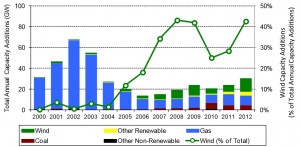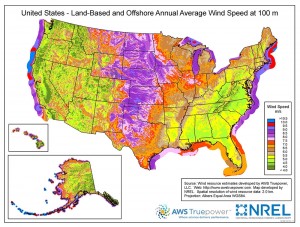Development
Historical context:
Though the technology has drastically improved, harnessing wind energy is not necessarily a new concept since windmills have been around for centuries. The first instance of utilizing this wind energy to generate electricity occurred in Denmark in the 1890s.[1] As the industrialization movement spread throughout the United States and Europe, they were generally replaced with steam engines. During the 1970s, the oil embargo created a shortage of fossil fuels which resulted in significantly higher prices. Along with changes in policy on wind electricity, research was done on the turbines in order to make them economically feasible. That is evident today as wind energy typically costs 4-6 cents per kWh.[2]
Current state:
Due to fact that wind electricity is relative cheap and environmentally friendly, there has been a significant increase in annual capacity installations over the last decade. This is evident with the figure below which shows how wind compares to other energy sources such coal, gas, and other renewables. In fact, wind electricity experienced the largest addition to cumulative capacity in 2012. Although it is not shown in the figure below, the was a drastic decline in the investment of wind electricity in 2013. This was partially due to uncertainty in tax credits that make installing turbines a better alternative than other energy sources. With the tax credits in place for 2014, it is expected that investments will normalize.

Source: EIA, Ventyx, AWEA, Interstate Renewable Energy Council, Solar Energy Industries Association/GTM Research, Berkeley Lab
By the end of 2013, the total installed wind capacity in the United States was around 61,110 MW.[3] Compared to other countries, the United States has the second highest capacity behind China (>75,000 MW).[4] However, the 61,110 MW capacity accounts for only about 4.1% of the total electricity generation according to the US Energy Information Administration so there is plenty of room for growth.[5] The degree of this growth will depend on future energy demands and technological advancements moving forward.
Future Outlook:
In order to drastically reduce our greenhouse gas emissions it is inevitable the development of renewable energy sources will play a major role. Wind energy in particular is a feasible option based on economics, technology, and policy. It is expected that future turbines will be able to achieve a 20 MW rating which will help to maximize capacity.[2] Another potential area of improvement is offshore wind turbines. Although the US currently has no plans to explore this option, it is being developed elsewhere and it is a major source of wind potential based on the figure below. Countries like the UK, Denmark, and Belgium are at the forefront of this technology.[4] The issues with offshore includes aesthetics and a more challenging installation which would result in higher capital costs.
An issue with wind energy is that it is not just not practical everywhere. As seen with the figure above, there is a large difference in wind speeds between states. The states with the higher potentials typically already have extensive wind farms in place so the remaining area to install more turbines is somewhat limited. Also, many of these states are not as heavily populated so electricity distribution needs to be considered.
The US Department of Energy established a goal for wind energy to supply 20% of all demand by 2030.[6]This would result in a cumulative capacity of 300,000 MW. In addition, this increased wind electricity production would lead to reduction of coal consumption by 409,200,000 tons and water by 450,000,000,000 gallons per year. While this would go along way in combating climate change and water shortages, we do not believe this is an attainable goal considering we would be quintupling our current capacity. We believe a 10-15% increase in the next 15 years is a more realistic goal and would still go a long ways in helping the environment. It is difficult to predict because the system is constantly changing, but we believe wind to be the most viable renewable energy source moving forward based on the information presented on this website.
References
1) “History.” Wind Energy Foundation. N.p., n.d. Web. 9 Apr. 2014. <http://www.windenergyfoundation.org/about-wind-energy/history>.
2) “Advantages and Challenges of Wind Energy.” Energy.gov. US Department of Energy, n.d. Web. 13 Apr. 2014. <http://energy.gov/eere/wind/advantages-and-challenges-wind-energy>
3) “U.S. Capacity & Generation – Issues.” American Wind Energy Association. N.p., 10 Apr. 2014. Web. 12 Apr. 2014. <http://www.awea.org/AnnualMarketReport.aspx?ItemNumber=6305&RDtoken=35392&userI>.
4)”Global Wind Statistics – 2012. Rep. Global Wind Energy Council, 2 Nov. 2013. Web. 3 May 2014.”
5) “AEO2014 Early Release Overview.” U.S. Energy Information Association. N.p., 16 Dec. 2013. Web. 11 Apr. 2014. <http://www.eia.gov/forecasts/aeo/er/early_elecgen.cfm>.
6) U.S. Department of Energy’s Wind Program—Lasting Impressions .US Department of Energy, 2012. Print.

